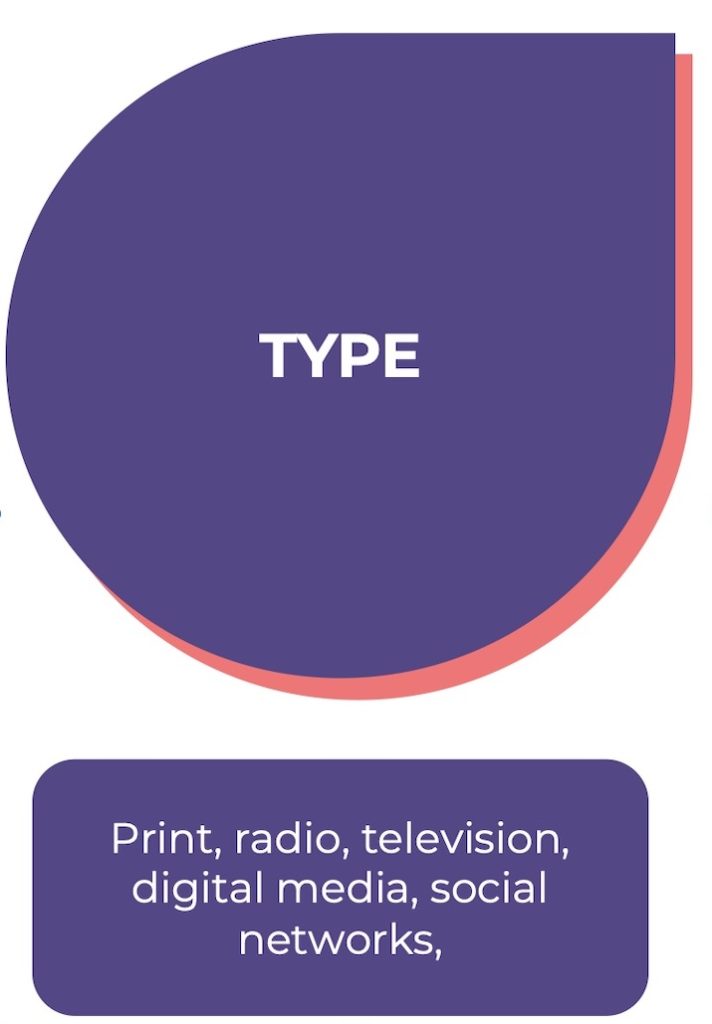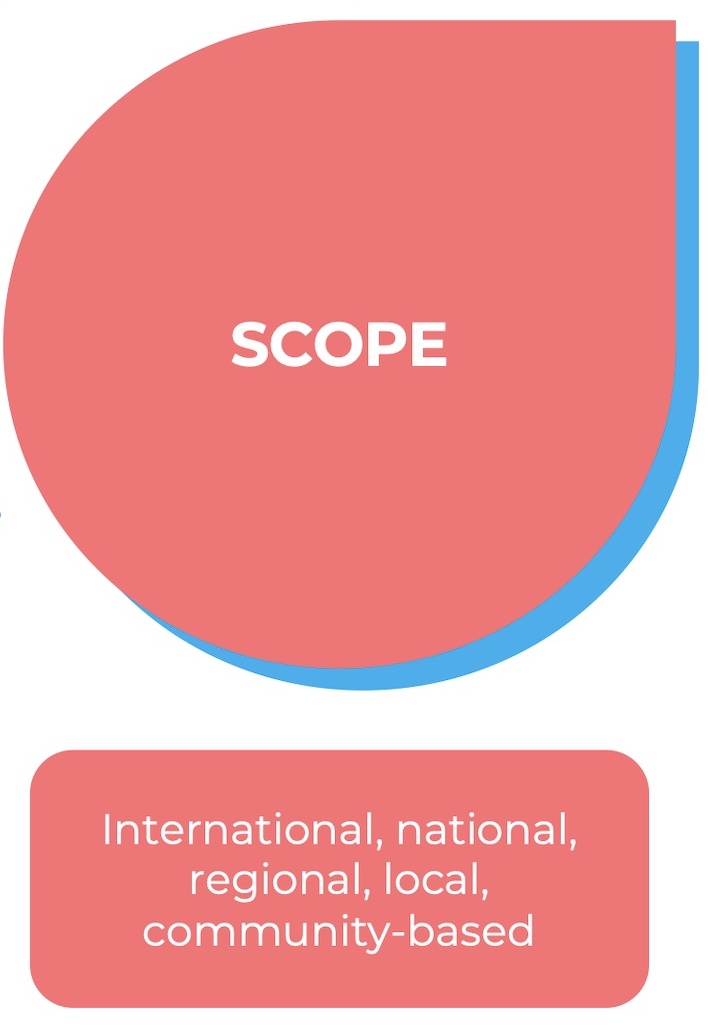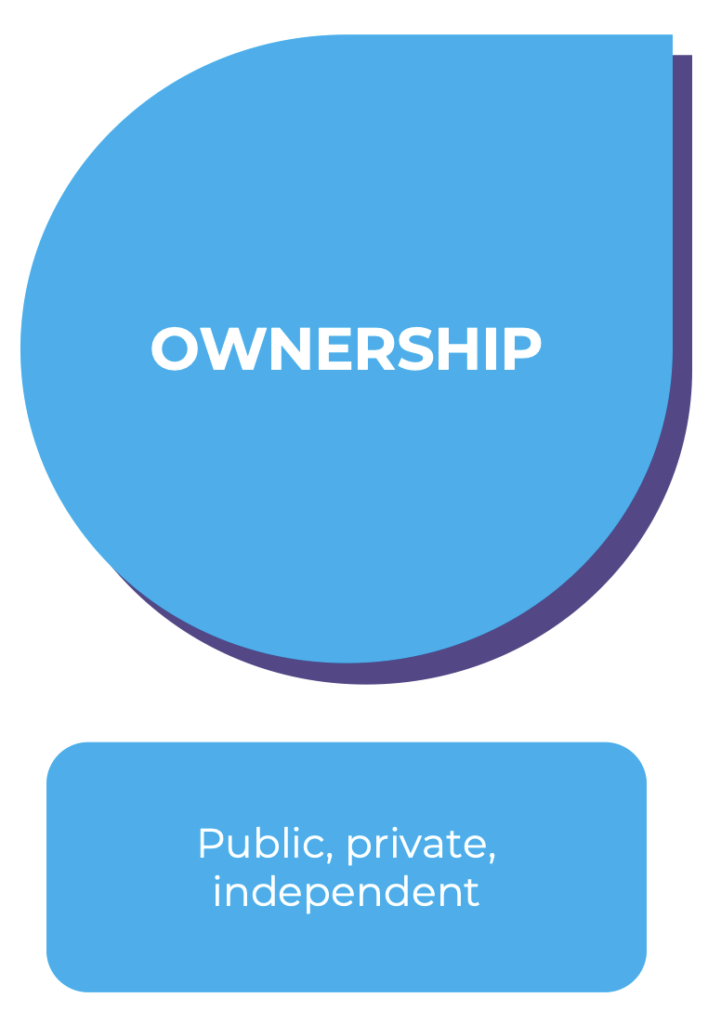Media Actors: type, scope, ownership, and influence. Copy Copy

Media Actors
Any organisation whose focus is to produce/disseminate/facilitate information to the public. In general terms, Media Actors can be defined by type, scope, and ownership.
Before working with the media, it is important to understand this behemoth institution. You need to know what types of media there are and choose the most appropriate based on your communications needs. This is a brief introduction to the diverse types, scope, and mandates of media. This description is to give a general idea of the most common types of media and demonstrates the complexity of the media landscape. It is important to know what kind of media you want to target, their channels, priorities, restrictions and of course, opportunities to contribute to the communication goals of your project.
We understand as ‘actors’ any organization whose focus is to produce, disseminate, or facilitate information to the public. Thinking specifically about this training and the types of media organizations that you might be interested in collaborating with, we will focus on media organizations that produce/disseminate/facilitate information relevant to SGDs delivery. Think of news outlets, governmental media programs, independent, and educational initiatives. In general terms, Media Actors can be defined by type, scope, and ownership. These factors are important when deciding which media organizations, you will want to collaborate with. For example, if you are working on a series of interviews to create awareness on a certain topic and you have a lot of audio materials, you might prefer to collaborate with a media organization that has a focus on that type of media. Similarly, if you are working on a campaign that seeks to change government policies on a certain topic you might need to collaborate with independent media organizations that have experience with that topic and legislation.
*Disclaimer: from a media study perspective, there are hundreds of theories and methodologies to define types, scopes, and mandates (ownership) of media, different organizations are using different terminologies and definitions, but it is what RNW Media proposes, such as based on the content types, some people categorize media into ‘news media’ and ‘non-news media’. Some people use the terminologies ‘mainstream media’ and ‘alternative media’, the former normally refers to mass media or organizations focused on mass communication (communicating to a large audience), but the latter is more focused on the characters of being non-profit, editorial independent or micro communication (communicate to a specific segmented population or small circle). Please be also aware that there are lots of media organizations that are mixed types.
Media Types

Media types, specifically, are in constant change due to technological innovations and the quick development of digital media. In what is known as ‘traditional media’ the common types are radio, print, and television. Alternatively, new media types can be categorized as video platforms, audio platforms, social networks, blogs, etc. Although making categories is useful for analysis, in practice we see it is increasingly difficult to classify media organizations into just one category because more and more so-called ‘traditional media’ is becoming more and more digital. It is common to see media organizations publish their content via different types of media: newspapers (printed and digitized), Articles (published on websites and social media,) and Reporting (TV or digital video platform like YouTube). Even in these cases, it’s important to notice what type of media each media organization focuses on more; this will help us decide whom to collaborate with based on the type of content we have .
- Traditional media: radio, print, and television
- New/digital media: video and audio platforms, social networks, websites, etc.
Media Scope

This category is used in mapping the media landscape because it refers to the reach and focuses that media outlets can have; think geographically, topics, and audience. Specifically, when the content is of social interest, like news, it is useful to know what the scope of each media producer is.
- International media, as the tag implies, usually provides information on world events, with correspondents and bureaus, placed all over the globe, e.g., CNN World News, BBC World News, Aljazeera, and China Global Television Network – CGTN).
- Regional media focuses on a geographic subregion, many international media broadcasters also have regional channels to provide more focused content, usually delivered in the predominant language (s) of the region e.g., BBC Africa, Aljazeera Arabic, CNN en Español and CGTN America), there are also many regional media platforms, such as The East African and the Pan African News Agency (PANAPRESS).
- National media usually work within the boundaries of a nation-state with a mandate to communicate on issues within, about and for the host country. National media can be narrowed down to local media, for example, those that work exclusively in certain provinces, regions or principalities, and community-based media.
- Local media: media outlets that work exclusively in certain provinces, often reflect on the problems of that locality, political and social and reflects the culture of this community.
- Community-based media is generally a sector of media production that is based in civil society and is usually non-profit. Even when its scope can be defined geographically, it is often the case that communities are defined around a specific topic or effort. Often community-based media focus on social change either by raising awareness or public participation.
Media Ownership

Every media outlet responds to a specific authority; it can be governmental like the public sector which is state-funded, private or corporate media which has a for-profit business model, or independent media which is non-profit and usually funded by donors. Besides the type and the scope, every media outlet responds to a specific authority; it can be governmental like the public sector which is state-funded, private or corporate media which has a for-profit business model, or independent media which are non-profit usually funded by donors. The mandates of media are important to understand because they determine much of the direction and strategies (operational models) of the content production and in many cases the editorial control.
- Public service broadcasting: is funded by governments, typically via annual fees charged to receivers. Some countries have a single organization which runs public broadcasting, other countries have multiple public-broadcasting organizations operating regionally or in different languages. Historically, public broadcasting was the dominant or only form of broadcasting, so often they have long trajectories. Public-sector media which are state-funded or highly subsidized, however, retain editorial control. State-owned media, on the other hand, is usually controlled both financially and editorially by the state. This distinction in editorial control is important for NGO&CSOs to identify.
- Private or corporate media: as the name implies works for profit. Most still use the advertiser-based revenue model, however, in the digital era other business models like subscription models are becoming more common. The primary mission of these media houses is to get target audiences desirable for advertisers or a population with enough disposable income to pay for information. Some for-profit media houses use a combined format, with commercial units as well as publicly subsidized operations.
- Independent media: are non-profit independent news media organizations funded by donors (individual, international and organizational) such as investigative journalism behemoth ProPublica and smaller regional media houses like OC media in Georgia.
- Community Media: any form of media that functions in service of or by a community, such as a local community newspaper or community WhatsApp group. Community media aids in the process of building citizenship, sharing common interests, promoting community harmony, and raising social awareness. Most communication media operated as a non-profit, and their operation is highly dependent on donor funding or community donation. Compared with other types of media, community-based media can facilitate a stronger bond between them and their community members and between community members.
Professional roles in news media
Keeping in mind that the objective of this training is to successfully collaborate with media organizations, we thought it might be useful to go over some of the roles and responsibilities most common in news media. This way you can know exactly who to reach out to with a proposal. This might come in handy when trying to establish collaborations or share a story. There is often a higher chance to have a story reported by pitching it to ‘the right correspondent.

Content related roles
- Journalist: a person who writes for newspapers, magazines, or news websites or prepares news to be broadcast. In large media organisations, journalists may specialize in only one task, but they may have to do multiple tasks in a small organisation, such as one person serving as both a reporter and a feature writer.
- Reporter: gathers information and writes stories covering all sorts of news stories. Reporters may work on the staff of news organizations, but may also work freelance, writing stories for whoever pays them.
- Correspondents: specialize in a field, such as sport, politics, business, or education, or they contribute to reporting from a remote, often distant location.
- Photographer or photojournalist: takes photographs to record news and current events. Sometimes they cover events with a reporter, by taking photographs to illustrate the written story or attending news events on their own, presenting both the pictures and a story or caption. Many photographers are freelancers. That means they do not work for any one organization but sell their images to several media outlets.
- Feature writers: work for newspapers and magazines and cover topics in more depth. Often, they write human-interest stories; longer stories which usually give background to the news. In small organisations, the reporters themselves will write feature articles.
Editorial & production-related roles
- Editor is the ‘boss’ of a newspaper and is ultimately responsible for what is published. Editors oversee the work of all the newspaper staff. They allocate space for articles, photographs, and advertisements, and decide which stories make it into each edition. They are responsible for the newspaper’s editorial voice, and often write editorial ‘leaders’ – opinion pieces placed in the editorial section usually at the end of the news pages. The editor is usually the person who makes the final decision about what is included in the newspaper, magazine, or news bulletins. They are responsible for all the content and all the journalists. Editors may have deputies and assistants to help them. Based on the size of the organisation and years of experience, there are junior editors, senior editors or chief editors.
- Producer: oversees the making of the programme, making sure that all the output is produced to a high standard. They coordinate the content working in close collaboration with presenters or other programme contributors. They manage the team to make sure everyone knows what they’re doing. As they have overall control and responsibility for the show, producers will keep an eye out for any potential legal problems. The person in charge of all the programs in that series is called the executive producer or EP.
Now, let’s go over some of the most common mistakes that organisations make when seeking to collaborate with media:
Common mistakes
- Working only with familiar media organisations – lack of new partner exploration
- Working with media without understanding their scope, type, and ownership properly
- Not having a clear Target Audience
- Not understanding the ways of working with the media (deadlines, procedures, etc.)
For example, a grassroots NGO whose mission is on community development in specific targeted geographic areas might have more impact on their final beneficiaries by working with community media or local media instead of international media.
Taking another example, a program that aims to raise awareness and share relevant factual SRHS information to marginalized communities from rural areas with no/limited internet access will benefit the most from working with media organisations that have reach to the community. Working with digital media organisations will not provide the desired impact but working with local TV, radio, and newspaper broadcasters will!
